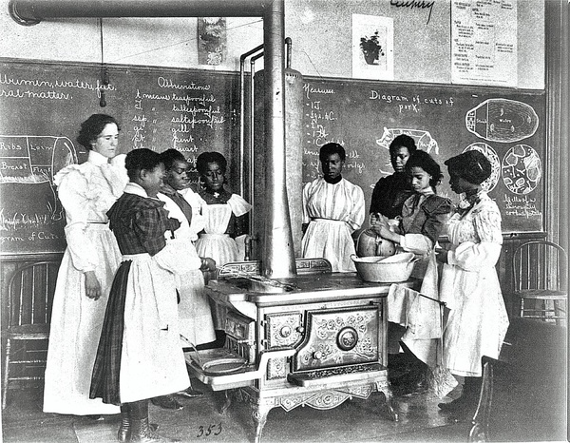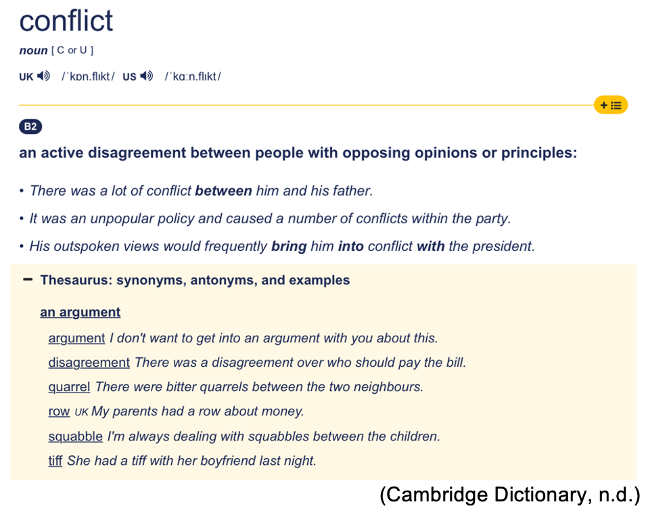Training is crucial for the development and success of a business and should benefit both employers and employees. Training programs are designed to help employees learn different skill sets to perform their daily tasks efficiently, improve overall performance and avoid violations of laws and regulations. (Gupta, 2021) Despite the cost of training to employers, the return on investment is immense when training is successfully implemented.
Have you been asked to perform a task in the workplace you’ve never done before? Describe what happened and how you felt in this situation.
Exercise 14
- Create a list of at least 10 benefits of staff training. (You may wish to research what others have said about this.)
“For a hospitality business to meet production and sales targets, a sensible business strategy is to regularly engage staff in training activities.”( Assessment 3.2 Task 3)
Exercise 15
- Define the following terms in the context of a restaurant. Include examples of both to illustrate the difference between the terms.
- Production Targets.
- Sales Targets.
- Check with your tutor to ensure your definitions are correct.
Self-Directed Learning
Visit the Ministry of Business, Innovation & Employment Hīkina Whakatutuki Website to read about training and development.
Read the article and in particular the two case studies.
What are some of the take-home messages relevant to the Cookery Industry?
Checkpoint
Assessment 3.2, Task 2
Goal setting is a proven way to achieve success. The best way to set restaurant goals is to look at areas where the business is struggling and find ways to improve them. Business targets – production or sales, should be designed so they can be measured to determine how successful the business has been in achieving them. The best way to achieve your restaurant goals (or any goals in fact) is to set S.M.A.R.T goals - Specific, Measurable, Attainable, Relevant, Time-based.
The trouble with not having a goal is that you can spend your life running up and down the field and never score.Bill Copeland
Exercise 16
There is a lot of information online explaining SMART goals and their relevance to achieving objectives. Research and fill in your own understanding of the SMART process in the table below. (You may prefer to copy the table to your journal.)
| S | |
|---|---|
| M | |
| A | |
| R | |
| T |
(SMART Goals: Definition and Examples, 2020)
Share
Think about the following questions and join the online discussion to post your thoughts.
- What is the value of setting a SMART goal?
- What is the greatest challenge you see in making SMART goals?
- How can a SMART goal help you distinguish between a wish and a goal? (SETTING SMART GOALS ACTIVITY, n.d.)
Rewrite the following goals as SMART goals, satisfying all five categories. The first one has been done for you.
- We will speed up our take-out service” can be rewritten as “We will decrease the wait time for take-out orders by 10% before June 30th this year”.
- “We will increase restaurant revenue in the near future”.
- “The establishment needs to boost social media engagement.”
- “Our goal is to improve employee retention.”
A goal without a deadline is just a dream.Robert Herjavec
Self-Directed Learning
We have looked at business goals but what about your personal career goals?
Many people drift from job to job or busily rush about while actually accomplishing very little. Setting SMART goals allows you focus your efforts use your time and resources productively. They give you a sense of direction and increase your chances of achieving what you want in life.
Before setting new career goals look back to any goals you have previously set and analyse the reasons why you did or didn’t reach them. Copy and complete in your journal:
- The previous career goal(s) I set were…
- The specific reasons why I did/didn’t achieve these goals were …
- The barriers I encountered to my previous goals were…
- I could have overcome these barriers and obstacles by…
- From my previous goal(s) I have learnt…
Now picture yourself 10 years from today and consider where you would like to be in your career, who you would like to be working with, and what you would like to be doing.
Use one of the SMART goal templates below or another of your choice to clarify your key career goal and how you will achieve it.
In order to meet production and sales targets it may be necessary to carry out a staff training needs analysis to define the focus of your staff training. Training is a feasible solution when the problem is caused by a lack of knowledge, skills or attitudes.
A training needs analysis is identifies the gaps between existing and desired levels of knowledge and skills and is conducted as follows
- Define the establishment’s (SMART) goals.
- Create a list of the desired skills, in order of importance and at the competence level required.
- Rate the current level of competence amongst the team.
- Identify gaps and decide which skills to focus on.
- Set learning objectives defining what employees will be able to do by the end of the training. (Use SMART goals.)
- Decide on training content.
- Develop the format of the training sessions – how to present the training. How do employees like to learn? The acronym VARK stands for the Visual, Aural, Read/Write, and Kinaesthetic sensory styles used in learning information.
When organising training sessions, find out the VARK learning preferences of those involved, and deliver information accordingly.
- Visual (V)-learners prefer information in charts, graphs, flow charts, labelled diagrams etc. rather than words. (This mode doesn’t include movies, videos, or PowerPoint however.)
- Aural / Auditory (A)- learners like information that is "heard or spoken", such as workshops, meetings, lectures, podcasts, group discussion, email, speaking, web chat, talking things through etc. Making statements and asking questions are important.
- Read/write (R)- is a preference for the printed word, especially lists, manuals, reports, minutes, guides, and legal documents. It includes PowerPoint presentations, the Internet, GOOGLE, and Wikipedia.
- Kinaesthetic (K)- learners relate best to actual experiences and things that are real (even when shown as images and on screens). These include case studies, demonstrations, simulations, videos, and movies of “real” things. They are ‘tactile’ learners who must be actively engaged in their learning.
Most of us are multimodal to some degree having no standout mode, allowing us to adapt more easily to different training modes.
Exercise 17
Identify your own learning preference from the descriptions above then check by completing a questionnaire on any online VARK site. (Two sites are provided here.)

Exercise 18
Suppose you have been asked to present a training session on how to prepare Fish and Vegetables en Papillote. Explain how to best engage:
- Kinaesthetic learners.
- Read/Write learners.
Self-Directed Learning
Watch the Kentucky Fried Chicken (KFC) video-based employee training program here, in which new cooks learn to make fried chicken.
Which learning preference(s) is being targeted? How effective did you find this as a training method? Would you make any improvements or adjustments? Post one comment on the discussion board.
Training can be split into two types:
- Daily/constant/ongoing training which is short and repeated.
- Long-term/innovation training which may occur less frequently but be used to introduce new ideas, new techniques and skills, or new products.
A combination of both types of training is the sensible way for a business to maintain standards and also to be innovative. So how can a business help achieve its targets through training?
Exercise 19
- In your journals, write your thoughts on the type(s) of training a business can carry out to help meet the production and sales targets defined in Exercise 13 on a:
- DAILY (ongoing/frequent) basis.
- MONTHLY (long-term) basis.
- Training is generally conveyed in two ways:
- On the job training is given to employees within the everyday working environment. It is a simple and cost-effective training method where workers ‘learn by doing’.
- Off the job training is provided away from the actual working environment.
- On-the-job versus Off-the-job Training is explained in the following video:
- As you view the video, summarise the two forms of training using these headings:
- Examples.
- Benefits.
- Drawbacks.
Self-Directed Learning
After investing valuable resources into training it is important to evaluate its effectiveness. Has the training programme met the learning objectives? Were the training materials and resources pitched at the appropriate level? Are there still any training gaps?
Research and discuss effective methods for evaluating staff training programmes.
In this Course 3.1 , we investigate and analyse ways to manage staff relationships in commercial hospitality operations. Our workplaces are often stressful and intense places to be, and a good sense of being part of a team is essential to make them manageable and efficient. Given the workforce can be very diverse, managing relationships between staff members is one of the most important, and most difficult tasks of a manager.
Through two realistic workplace scenarios we will look at the issues of:
- Conflict resolution.
- Communication.
- Cultural awareness.
- Teamwork.
What is conflict?

(Conflict, n.d.)
Conflict is a normal part of our lives, dealing with people with different ideas, opinions and objectives to our own often causes us to disagree with others. We may disagree about politics, sport, food, music, art – in fact we probably all have an opinion (strong or otherwise) about just about every facet of our lives.
At work, even as part of a team working towards a common goal we may have different ideas of how to achieve that goal. Conflicts may bring up disagreements, but successful management of these situations does not necessarily meant there is a winner and a loser of the outcome. Managing disagreements in an open and respectful way often leads to improved outcomes.
What does workplace conflict look like?
Workplace conflict can appear in different forms and for different reasons: from personality clashes to cases of bullying and harassment. (Dealing with Conflict at Work: A Guide for People Managers, 2021.)
Some sources of conflict include:
- Behavioural:
- Bullying/harassment.
- Discrimination.
- Attendance/time-keeping.
- Poor performance.
- Offensive language/gestures.
- Alcohol/drug problems.
- Other sources of conflict:
- Differences in personality.
- Differences in working habits.
- Ignoring value of other views and experience / lack of respect.
- Arrogance or trying to take control over other people.
- Non-inclusion or ignoring of others in communications and decision-making.
- Lack of consistency in decision-making or hypocrisy.
Exercise 20
Read Scenario A of the assessment, then identify the types of sources of conflict shown in the story. Make a note of the specific example which shows that conflict source.
Checkpoint
Assessment 3.2, Task 2
